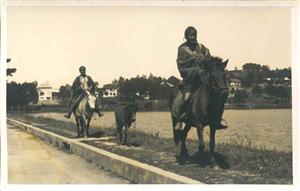| 5/6 - A difficult topic: some hints on how to approach it |
| |
The heterogenous nature of the images collected here is their major handicap indeed when seen from a strict anthropological angle. The documents are of different periods and origins, and concern highlander populations which have evolved like any other human society, but were more exposed in the process, considering the pressures brought to bear on them as suggested above. Furthermore, some images, some of them only faintly identified, concern human groups with widely different social or cultural organisations. The risk incurred is the production of yet another essentialist approach 1 of the type which has flourished in publications on these populations; the ruling categorisation explicit in the term Montagnards implies running such a risk.
But the risk incurred carries with it corresponding hopes of positive returns in apprehending indigenous societies in their present precipitated evolution.The symbolic productions accompanying such drastic transformations may find original channels of expression in the very machinery of imagery as found in this set of visual documents. |
|
convey autonomous symbolic power, self-generating and interlinking according to sometimes purely graphic modes.
It thus comes as no surprise on Southeast Asian grounds to encounter part of the mechanisms felt in Northern America, with the exception of mass massacres. Being raised from childhood on stories of the conquest of the North American West, many authors draw a parallel between Montagnards of Indochina and American Indians. Such is the case with Roland Dorgelès. Image become stimulus. Thus with a photograph of Montagnards riding through Dalat, reminiscent of the work of Edward S. Curtis; or Père Simonnet's comment on a photograph of a Banhar chief as an "Amerindian figure". Young American military men fighting in Vietnam in the sixties of the 20th century behaved as natural heirs, illustrators and redeemers of an already long tradition when they felt they were "saving these people from communist subjection". Several of them then traded gun for pen and camera and turned ethnologists or photographers. |
|
 Two women riding horses on the side of a lakeside street,
Two women riding horses on the side of a lakeside street,
a colt between the two horses. - Unknown photographer and date
|
| |
The production of images, singularly photography with its critical (i.e. selective) potential is seen here as a key component of the process of appropriation and domestication of the human reality of the uplands 2. Images remove the physical presence (not the connotative presence) of certain physical components of the situation envisaged: temperature, smells, sounds, speech. They also remove the non-visual, cultural or imaginary, dimensions of the same situations. What is left then is open on the one hand to ethnographic work, on the other hand to the propounding of certain easily perceived and easily assimilated archetypes - "jungle", "wild animal", "tribe", "chief", "warrior", "hunter", "mother and child", and of course the erotic nude coming in to spice up all situations.
Such archetypes are elementary components of conventional representation. By association of ideas they also mix with images from pre-existing collections: for instance religious iconography or the more recent representations of American Indians. Such documents of course are ideological productions but they also |
|
But are we now in a position to evaluate the popularity of these images, and the consequent success of the symbolic mechanism of regrouping, familiarisation and appropriation? Our answer is yes. Whereas few people in the West have had access to books or administrative reports on Montagnards, a large number have come in contact with articles in the press often illustrated and a still greater number received, bought or even collected postcards long before cameras became accessible to a wider public. The popularity of images of Montagnards also derives from another above mentioned characteristic - "nudes". The nude (barring sexual parts) acted as a potent erotic magnet for Europeans only just emerging from prudish tight-laced 19th century puritanism - especially when it concerned populations of peninsular or insular Southeast Asia, as encapsulated in the characterisation of Bali as the "Island of naked breasts". A trade of prurient images was an early consequence, thriving on the practical alibi of the exotic and the wild. It ought to be a matter for some surprise that such a trade should persist in the age of Internet and mass diffusion of erotic and pornographic images - especially since its modes remain rather close to those of the origins, further stressed by the official stance of prudery taken by many Asian countries.
|
|
|

